This week, we look into the only known “funny animal” comic book work by two MGM animators with brief directorial stints, George Gordon and Preston Blair!
George Gordon started his animation career at Paul Terry’s studio, as an assistant to head animator Frank Moser, in 1930. In 1936, when Moser departed the studio, after losing a court case against Terry and Educational Pictures over company shares, Gordon was appointed as the head of the animation department. He directed several Terrytoons with Farmer Al Falfa, Kiko the Kangroo and Puddy the Pup. A year later, in the summer of 1937, many of the key animators flocked to MGMs newly established animation department in the West Coast. Terry offered Gordon a substantial amount of money to stay at the studio, but was left without a story department. Gordon helped Tom Morrison – promoted as a story-man after the exodus – with The Dog and the Bone, before leaving for MGM.
By early October 1937, Gordon was hired on the Captain and the Kids cartoons as a layout artist and animator. He animated for Hugh Harman, Rudy Ising and the Hanna-Barbera unit throughout the late ’30s and early ’40s. In July 1942, Gordon became a director at the studio, sometime before Ising left to assume charge of the Army Air Force’s animation unit months later. He directed three “one-shot” cartoons, The Storks Holiday (1943), Innertube Antics and The Tree Surgeon (both 1944), along with two Barney Bear entries, Bear Raid Warden and Barney Bear’s Polar Pest (both 1944). Gordon left the studio in 1943 to join the Army Air Force, as a director on the “Trigger Joe” and “Seaman Tarfu” training films, sub-contracted by Hugh Harman Productions. (Though Gordon is often credited for The Unwelcome Guest, a Barney Bear released in February 1945, animator Mike Lah was the actual director, since Gordon had already left by the time production began.)
In the mid-’40s, Gordon left moved to John Sutherland Productions as a director on the Daffy Ditties, a stop-motion series that later shifted to full animation before distributor United Artists dissolved their contract between them in 1947. He stayed with Sutherland, as a director on his industrial films. By 1951, in addition to his duties as a writer and director, Gordon was promoted to associate producer. In May 1958, Gordon left Sutherland and joined Le Ora Thompson and Associates in Hollywood, as vice-president and executive production manager, only to arrive back by the early 60s.
He went back into animation at UPA as a story editor on The Famous Adventures of Mr. Magoo television series, and as a director on The Deputy Dawg Show for CBS-Terrytoons. In the mid-’60s, he was back at Sutherland; by 1967, he was promoted to vice-president of the company. Gordon went to work at DePatie-Freleng as a director for a brief period, and by the early ’70s, migrated over to Fred Calvert Productions as a story director. Gordon served these same duties when he moved to Hanna-Barbera – also as an animation director – until the early ’80s. He passed away in 1986 at the age of 79.
Heres Gordon’s comic book story, “Doc Owleye, Crime Dopester,” published for Goofy Comics #10 (August 1945), shown here (Click pages to enlarge). Though the story is initialed G.G. on the first panel, the drawing/posing in this story is similar to his animation in the early 40s, in particular, the early Tom and Jerry cartoons.
PRESTON BLAIR
Born in 1908, Blair attended Pomona College, where he served as the art director of the school’s humor magazine, The Sagehen, named after its mascot. He went to the Otis Art Institute to pursue his craft, and studied under magazine illustrator Pruett Carter at Chouinard Art Institute (now known as CalArts). He started his career in animation at the Romer Grey studio in 1930. When the studio hadnt kept up with his salary, he moved to Walter Lantzs studio, where he became an in-betweener, and was later promoted to assistant animator.
Charles Mintz’s studio offered a higher salary to artists, so Blair left Lantz and moved there, where he rose to full animator. In October 1937, he was hired at the Disney studios, where he animated on several short cartoons and feature films such as Pinocchio, Fantasia and Bambi. Blairs career at Disney was curtailed when he was one of the many artists laid off during the strike on September 12th, 1941.
Blair accepted an offer to work at MGM and became an animator for Tex Avery, along with Ray Abrams, Irv Spence and ex-Disney animator Ed Love. Of all the films he animated for Avery, his most notable work appeared in Red Hot Riding Hood (1943), where he handled the alluring nightclub singer of the same name.
By early 1946, producer Fred Quimby put Blair into a directorial unit with Mike Lah. The duo only lasted a short period, as they completed only three Barney Bear cartoons. In addition to cost overruns, Quimby dissolved the Blair-Lah unit when John Sutherland struck a deal to release his educational films through MGM.

Model Sheet for Lah & Blair’s “Goggle Fishing Bear” (1949)
After he left MGM, Blair became a magazine illustrator. He animated on Rodney (copyrighted 1950), an educational film sponsored by the National Tuberculosis Association and produced by Film Graphics, a firm run by Blair’s brother Lee. In 1948, he moved to Westport, Connecticut and formed Preston Blair Productions, which specialized in animated commercials and educational films. By the ’60s, his company ventured into television series when he directed on one episode of The Flintstones. By coincidence, Blair also developed and pitched an animated series based on the popular hit show The Honeymooners. The show wasn’t picked up, though its preliminary artwork exists.
Around 1962, Blair worked with Fred Ladd and Norm Prescott on their feature Journey Back to Oz, drawing the production storyboards and supervising the animators at the Zagreb studio in Yugoslavia. After a preview of the first six minutes of the film produced by Zagreb proved unsuccessful, Blair left the project to Prescott. Released in 1974, Journey Back to Oz credits Blair as an associate producer.
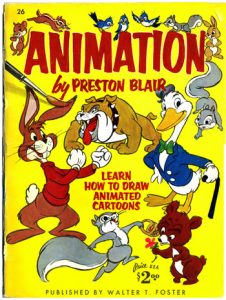 In the early ’70s, Blair worked in New York, animating on the “Freakies” cereal commercials for Zanders Animation Parlour. Later, he associated with a large school system in Louisville, Kentucky, developing and patenting educational methods, such as games teaching basic arithmetic using devices and calculators, and systems to tutor in reading. He returned to California in 1984, and settled in Carmel, California, where the expansion of video technology led him to develop animated methods and interactive game action for educational purposes. He retired in 1992 and moved to Soquel, California, with his wife Hope. He passed away in 1995 at the age of 85.
In the early ’70s, Blair worked in New York, animating on the “Freakies” cereal commercials for Zanders Animation Parlour. Later, he associated with a large school system in Louisville, Kentucky, developing and patenting educational methods, such as games teaching basic arithmetic using devices and calculators, and systems to tutor in reading. He returned to California in 1984, and settled in Carmel, California, where the expansion of video technology led him to develop animated methods and interactive game action for educational purposes. He retired in 1992 and moved to Soquel, California, with his wife Hope. He passed away in 1995 at the age of 85.
While at MGM, Blair authored and drew an instructional book on the principles of animation [LINK], first published by Walter T. Foster in 1948. It originally cribbed many of Blair’s scenes from Avery’s cartoons and character model sheets from MGM. As the book was reprinted over time, and expanded into two separate volumes, similar generic characters took their place. Blair’s animation books are still in print- in their revised forms – and continue to influence aspiring animators to this day.
Here’s Preston Blair’s comic book story, “The Secret of Success,” published for Ha-Ha Comics #25 (January 1946). Click pages to enlarge. As comic historian Dave Bennett noted in a previous column, Blair was paid only $8 per page for this freelance assignment compared to the average of $15 per page, according to Jack Bradbury. These lower wages could certainly be why he stuck mainly with animation.

(Thanks to Mark Kausler, Michael Barrier, Thad Komorowski and Yowp for their help.)



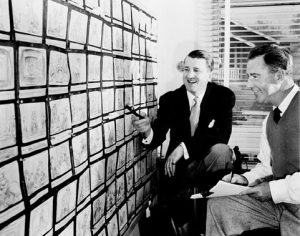
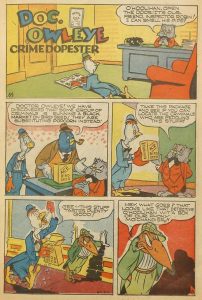
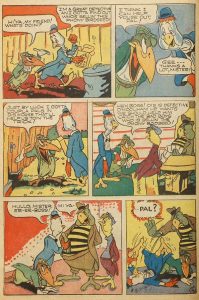
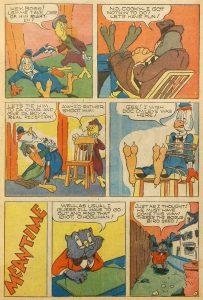
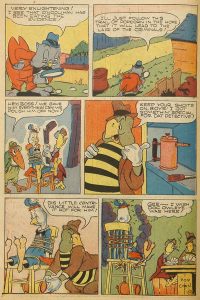
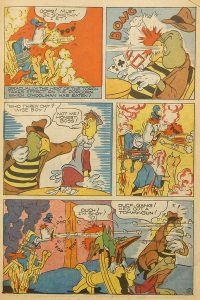
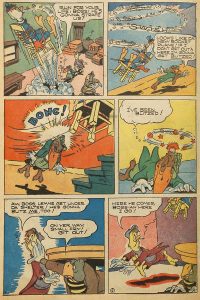

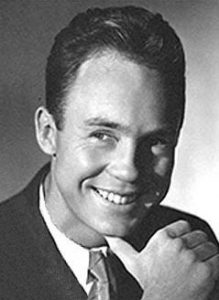
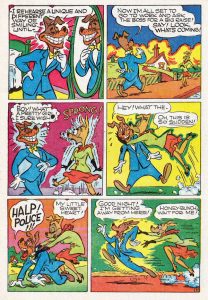
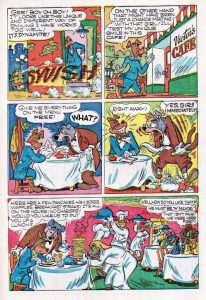
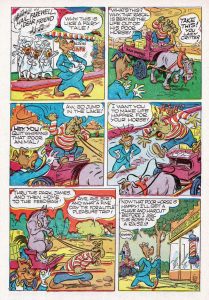


 DEVON BAXTER is a film restoration artist, video editor, and animation researcher/writer currently residing in Pennsylvania. He also hosts a
DEVON BAXTER is a film restoration artist, video editor, and animation researcher/writer currently residing in Pennsylvania. He also hosts a 




















































































Lovely inking..
Love Blair’s comic shown here!
I agree- Blair’s style is delightful!
Fortunately as an animator Blair could follow Tex and other’s poses, because the tangents in his comic story are certainly something. He made the right choice!
I’ve always felt that “The Tree Surgeon” has one of the weirdest and most terrifying endings in all of cartoons.